Impacts of Thermal and Mechanical Cycles on Electro-Thermal Anti-Icing System of CFRP Laminates Embedding Sprayable Metal Film
Abstract
:1. Introduction
2. Materials and Experimental Procedures
2.1. Materials and Specimen Fabrication
2.2. Experimental Tests
2.2.1. Thermal Cycling Test
2.2.2. Mechanical Cycling Test
3. Results and Discussion
3.1. Temperature Test
3.2. Thermal Cycling Test
3.3. Static Tensile Test
3.4. Mechanical Cycling Test
- The structure layer can be constructed with materials of higher elastic modulus, and the stacking sequence of carbon fiber can be optimized to improve the stiffness. In the case of a certain load, the greater the stiffness of the structure, the smaller the deformation. The electric resistance of SMF will increase considerably when the strain has a large value due to their nonlinear relationship. If the strain can be controlled at a small value during the flight, the increase of the electric resistance can be effectively restrained.
- The manufacturing process of SMF can be improved to reduce the porosity and densify the deposition, so as to make SMF closer to the continuous medium. If SMF has an elastic deformation stage, it can return to or approximate the initial state after a certain load and the functional fatigue life can be improved.
4. Conclusions
- The TCR of SMF measured in the temperature test has a positive value, which indicates that the electric resistance increases with the rise of temperature. Nevertheless, within the system operating temperature range of −55~80 °C, the change of the electric resistance is no more than ±0.2%. It can be considered that the temperature change has little influence on the electric resistance of SMF. In the thermal cycling test, it is found that the electric resistance gains with the number of cycles. After 1000 cycles, the electric resistance was increased by 20% and the output heating power was decreased by 16.67%. The thermal cycle will lead to a heating performance degradation without affecting the structural integrity of the system.
- In the static tensile test, it is found that the electric resistance of SMF increases nonlinearly with the strain. After the loading-unloading process, the electric resistance of SMF becomes larger than that of initial state. Under the repeated mechanical cycles, this effect will be accumulated and strengthened, which will give rise to the increase of the electric resistance with the number of cycles. Additionally, the various amplitude of the mechanical cycle has a different influence on the fatigue life of the specimen. The larger the amplitude of the mechanical cycle, the shorter the fatigue life of the specimen. Before the structural damage of the specimen, the output heating power starts to decrease and the heating performance is degraded, which indicates that the functional fatigue life is shorter than the structural fatigue life.
Author Contributions
Funding
Institutional Review Board Statement
Informed Consent Statement
Data Availability Statement
Acknowledgments
Conflicts of Interest
References
- Lynch, F.T.; Khodadoust, A. Effects of ice accretions on aircraft aerodynamics. Prog. Aerosp. Sci. 2001, 37, 669–767. [Google Scholar] [CrossRef]
- Thomas, S.K.; Cassoni, R.P.; MacArthur, C.D. Aircraft Anti-Icing and De-Icing Techniques and Modeling. J. Aircr. 1996, 33, 841–854. [Google Scholar] [CrossRef]
- Rösner, H.; Jockel, K.M. Airbus airframe-new technologies and management aspects. Mater. Werkst. 2010, 37, 768–772. [Google Scholar] [CrossRef]
- Mrazova, M. Advanced composite materials of the future in aerospace industry. INCAS Bull. 2013, 5, 139–150. [Google Scholar]
- AL-Khalil, K.M., Jr.; Keith, T.G.; De Witt, K.J. Thermal Analysis of Engine Inlet Anti-Icing Systems. In Proceedings of the 27th AIAA Aerospace Sciences Meeting, Reno, NV, USA, 9–12 January 1989. [Google Scholar]
- Ingram, C.; Dendinger, T.; Inclan, E. Integrating Subsystem Sizing into the More Electric Aircraft Conceptual Design Phase. In Proceedings of the 53rd AIAA Aerospace Sciences Meeting, Kissimmee, FL, USA, 5–9 January 2015. [Google Scholar]
- Kang, J.; Kim, H.; Kim, K.S. High-performance graphene-based transparent flexible heaters. Nano Lett. 2011, 11, 5154–5158. [Google Scholar] [CrossRef]
- Volman, V.; Zhu, Y.; Raji, A.R.O. Radio-frequency-transparent, electrically conductive graphene nanoribbon thin films as deicing heating layers. ACS Appl. Mater. Interfaces 2014, 6, 298–304. [Google Scholar] [CrossRef]
- Kim, T.; Chung, D.D.L. Carbon fiber mats as resistive heating elements. Carbon 2003, 41, 2436–2440. [Google Scholar] [CrossRef]
- Yoon, Y.H.; Song, J.W.; Kim, D.; Kim, J. Transparent film heater using single-walled carbon nanotubes. Adv. Mater. 2007, 19, 4284–4287. [Google Scholar] [CrossRef]
- Feng, C.; Liu, K.; Wu, J.S.; Liu, L.; Cheng, J.S. Flexible, stretchable, transparent conducting films made from superaligned carbon nanotubes. Adv. Funct. Mater. 2010, 20, 885–891. [Google Scholar] [CrossRef]
- Chu, H.T.; Zhang, Z.C.; Liu, Y.J.; Leng, J.S. Self-heating fiber reinforced polymer composite using meso/macropore carbon nanotube paper and its application in deicing. Carbon 2014, 66, 154–163. [Google Scholar] [CrossRef]
- Yao, X.D.; Hawkins, S.C.; Falzon, B.G. An advanced anti-icing/de-icing system utilizing highly aligned carbon nanotube webs. Carbon 2018, 136, 130–138. [Google Scholar] [CrossRef] [Green Version]
- Falzon, B.G.; Ronbinson, P.; Frenz, S.; Gilbert, B. Development and evaluation of a noval integrated anti-icing/de-icing technology for carbon fibre composite aerostructures using an electro-conductive textile. Compos. Part A 2015, 68, 323–335. [Google Scholar] [CrossRef] [Green Version]
- Chung, Y.W. De-icing system chosen for Boeing 787. J. Fail. Anal. Prev. 2005, 5, 36. [Google Scholar]
- Mohseni, M.; Amirfazli, A. A novel electro-thermal anti-icing system for fiber-reinforced polymer composite airfoils. Cold Reg. Sci. Technol. 2013, 87, 47–58. [Google Scholar] [CrossRef]
- Chen, L.; Zhang, Y.D.; Wu, Q. Effect of Graphene Coating on the Heat Transfer Performance of a Composite Anti-/Deicing Component. Coatings 2017, 7, 158. [Google Scholar] [CrossRef]
- Lu, P.B.; Cheng, F.; Ou, Y.H.; Lin, M.Y. A flexible and transparent thin film heater based on a carbon fiber/heat-resistant cellulose composite. Compos. Sci. Technol. 2017, 153, 1–6. [Google Scholar] [CrossRef]
- Buschhorn, S.T.; Lachman, N.; Gavin, J.; Wardle, B.L. Electrothermal Icing protection of Aerosurfaces Using Conductive Polymer Nanocomposites. In Proceedings of the 54th AIAA/ASME/ASCE/AHS/ASC Structures, Structural Dynamics, and Materials Conference, Boston, MA, USA, 8–11 April 2013. [Google Scholar]
- Alderliesten, R.C.; Hagenbeek, M.; Homan, J.J.; Hooijmeijer, P.A. Fatigue and Damage Tolerance of Glare. Appl. Compos. Mater. 2003, 10, 223–242. [Google Scholar] [CrossRef]
- Vermeeren, C.A.J.R. An Historic Overview of the Development of Fibre Metal Laminates. Appl. Compos. Mater. 2003, 10, 189–205. [Google Scholar] [CrossRef]
- Müller, B.; Hagenbeek, M.; Sinke, J. Thermal cycling of (heated) fibre metal laminates. Compos. Struct. 2016, 152, 106–116. [Google Scholar] [CrossRef]
- Hagenbeek, M.; Sinke, J. Effect of long-term thermal cycling and moisture on heated Fibre Metal Laminates and glass-fibre epoxy composites. Compos. Struct. 2019, 210, 500–508. [Google Scholar] [CrossRef]
- Hagenbeek, M.; Sinke, J. Effect of thermal cycling heated Fibre Metal Laminates under static load. Compos. Struct. 2019, 211, 540–545. [Google Scholar] [CrossRef]
- Gigliotti, M.; Lafarie-Frenot, M.C.; Lin, Y.G.; Pugliese, A. Electro-mechanical fatigue of CFRP laminates for aircraft applications. Compos. Struct. 2015, 127, 436–449. [Google Scholar] [CrossRef]
- Harizi, W.; Azzouz, R.; Martins, A.T.; Hamdi, K.; Aboura, Z.; Khellil, K. Electrical resistance variation during tensile and self-heating tests conducted on thermoplastic polymer-matrix composites. Compos. Struct. 2019, 224, 111001. [Google Scholar] [CrossRef]
- Khosravani, M.R.; Weinberg, K. Experimental investigations of the environmental effects on stability and integrity of composite sandwich T-joint. Mater. Werkst 2017, 48, 753–759. [Google Scholar] [CrossRef]
- Fujimoto, K.; Hojo, M.; Fujita, A. Low cycle fatigue of CFRP laminated composites due to repeated out-of-plane loading. Procedia Struct. Integr. 2016, 2, 182–189. [Google Scholar] [CrossRef] [Green Version]
- Funari, M.F.; Lonetti, P. Initiation and evolution of debonding phenomena in layered structures. Theor. Appl. Fract. Mech. 2017, 92, 133–145. [Google Scholar] [CrossRef]
- Xu, D.D.; Liu, Z.L.; Liu, X.M.; Zeng, Q.L.; Zhuang, Z. Modeling of dynamic crack branching by enhanced extended finite element method. Comput. Mech. 2014, 54, 489–502. [Google Scholar] [CrossRef]
- Hwang, W.; Han, K.S. Fatigue of Composites-Fatigue Modulus Concept and Life Prediction. J. Compos. Mater. 1986, 20, 154–165. [Google Scholar] [CrossRef]
- Vassilopoulos, A.P.; Georgopoulos, E.F.; Dionysopoulos, V. Artificial neural networks in spectrum fatigue life prediction of composite materials. Int. J. Fatigue 2007, 29, 20–29. [Google Scholar] [CrossRef]
- Lian, W.; Yao, W.X. Fatigue life prediction of composite laminates by FEA simulation method. Int. J. Fatigue 2010, 32, 123–133. [Google Scholar] [CrossRef]
- ASTM International. ASTM D3039/D3039M-17. In Standard Test Method for Tensile Properties of Polymer Matrix Composite Materials; ASTM International: West Conshohocken, PA, USA, 2017. [Google Scholar]
- ASTM International. ASTM D7615/D7615M-19. In Standard Practice for Open-Hole Fatigue Response of Polymer Matrix Composite Laminates; ASTM International: West Conshohocken, PA, USA, 2019. [Google Scholar]
- Mivehchi, H.; Varvani-Farahani, A. The effect of temperature on fatigue strength and cumulative fatigue damage of FRP composites. Procedia Eng. 2010, 2, 2011–2020. [Google Scholar] [CrossRef] [Green Version]
- Starke, E.A., Jr. Accelerated Aging of Materials and Structures: The Effects of Long-Term Elevated-Temperature Exposure; National Academy Press: Washington, DC, USA, 1996. [Google Scholar]
- Liang, C.B. Electromagnetics, 2nd ed.; High Education Press: Beijing, China, 2004; pp. 125–126. [Google Scholar]
- Clerk, M.J. A Treatise on Electricity and Magnetism, 3rd ed.; Dover Publication Inc.: New York, NY, USA, 1954; pp. 64–65. [Google Scholar]
- Hashin, Z.; Shtrikman, S. A variational approach to the theory of the elastic behavior of multiphase materials. J. Mech. Phys. Solids 1963, 11, 127–140. [Google Scholar] [CrossRef]


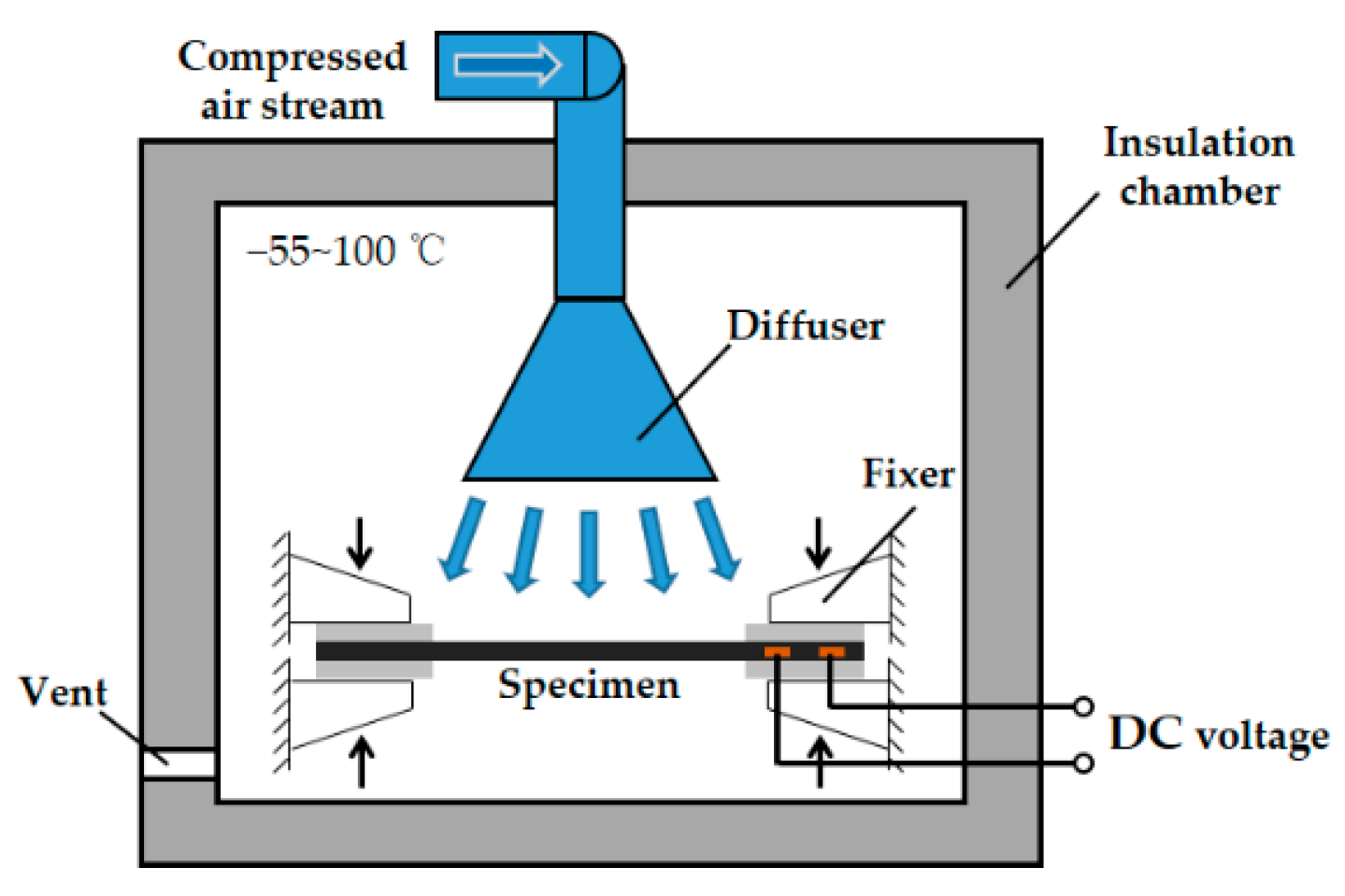
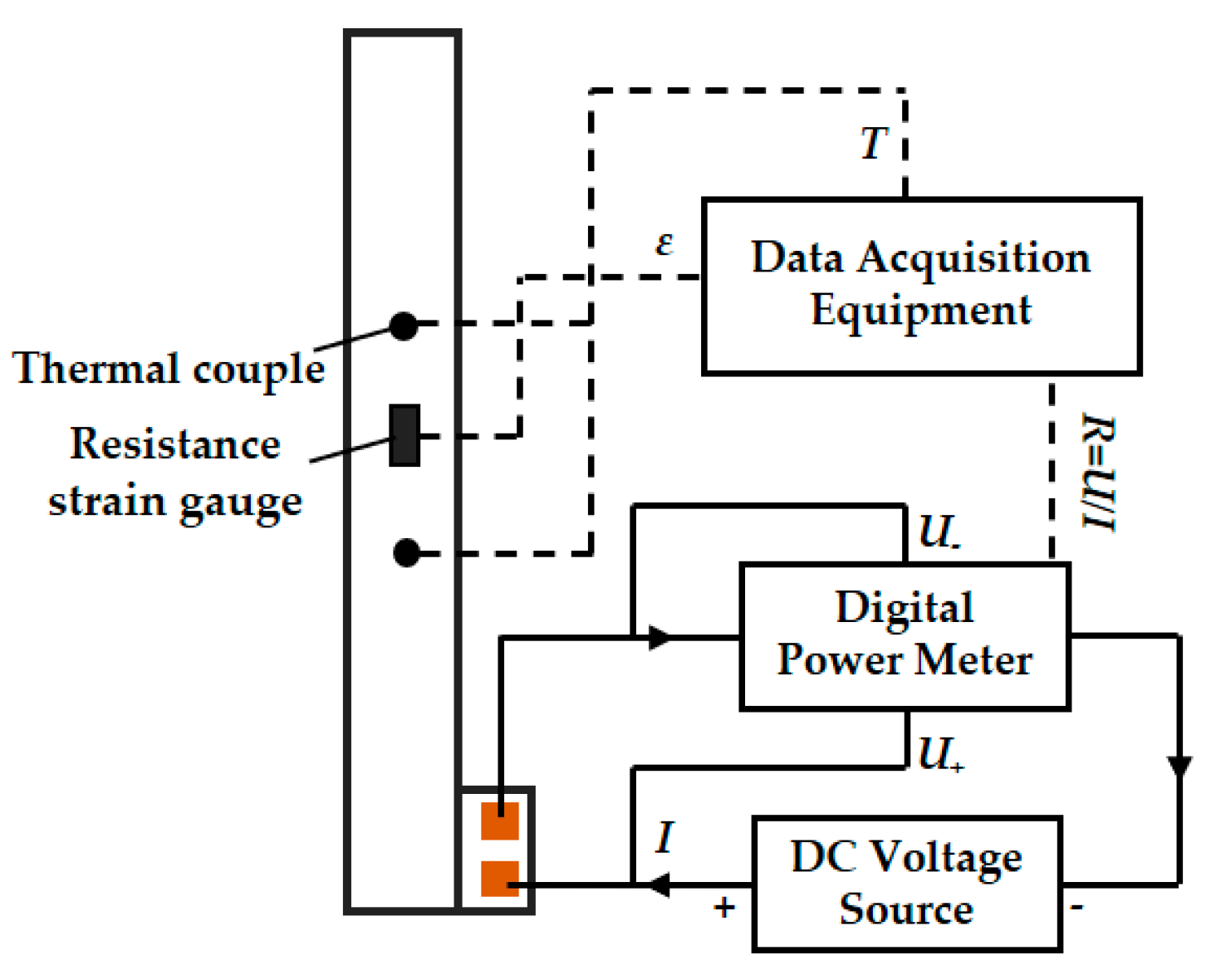
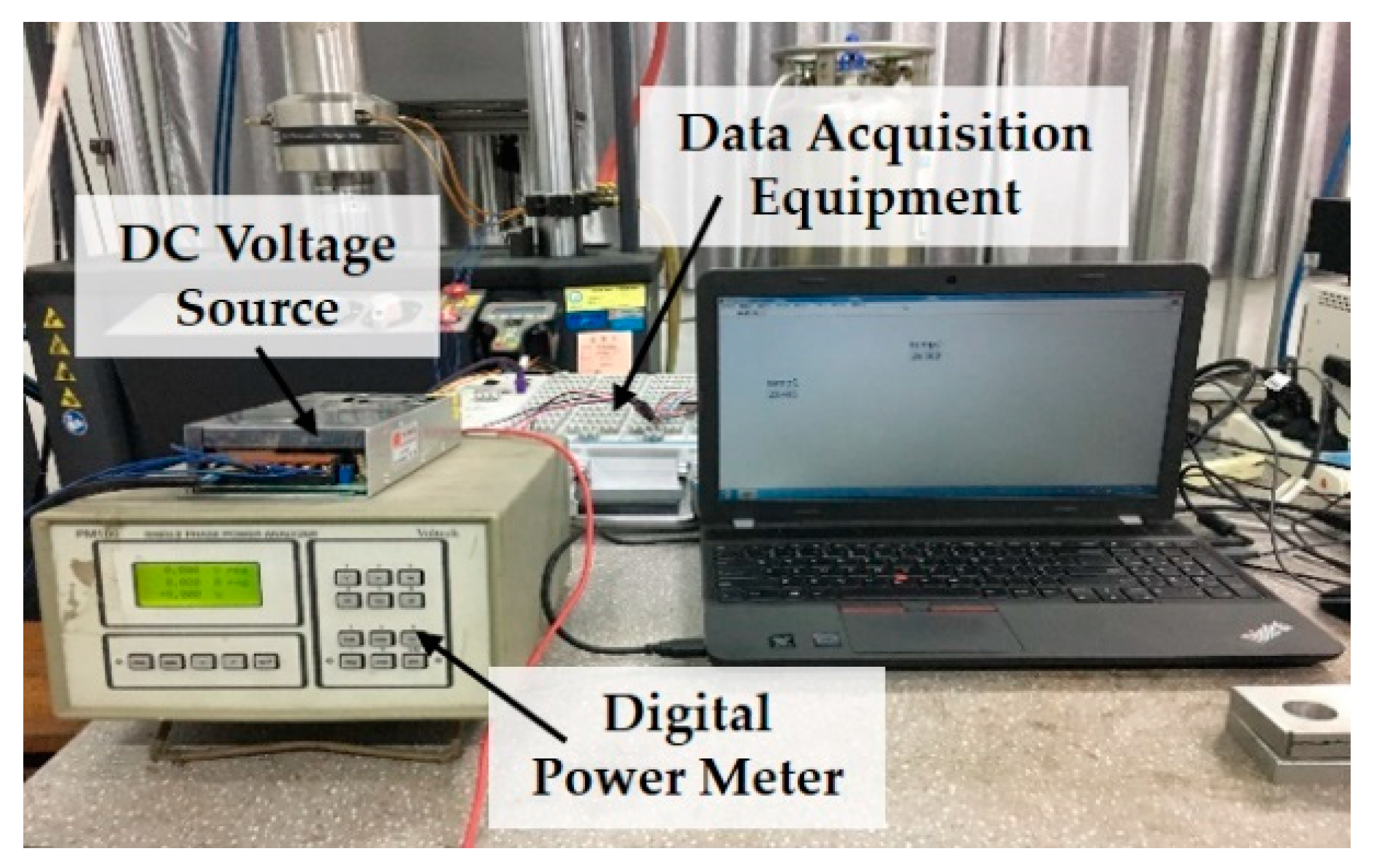
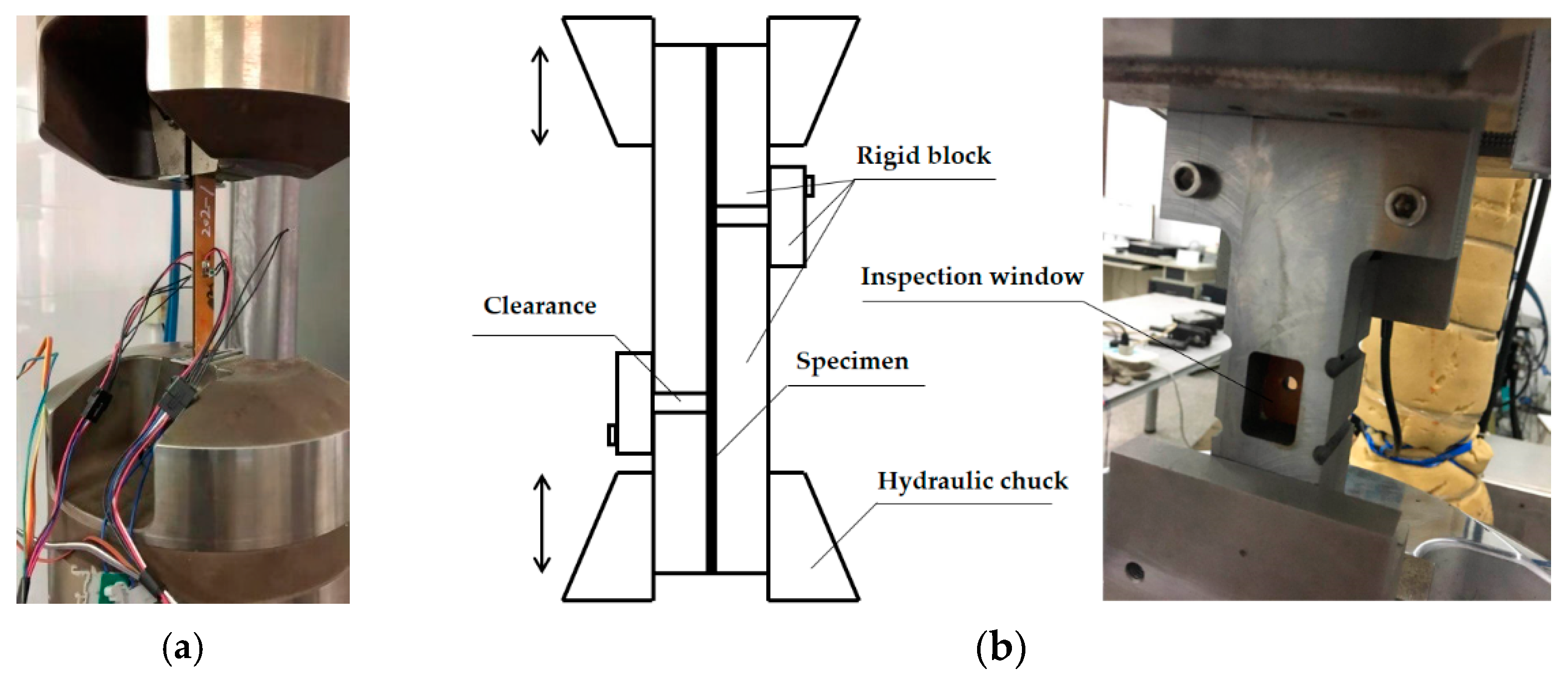
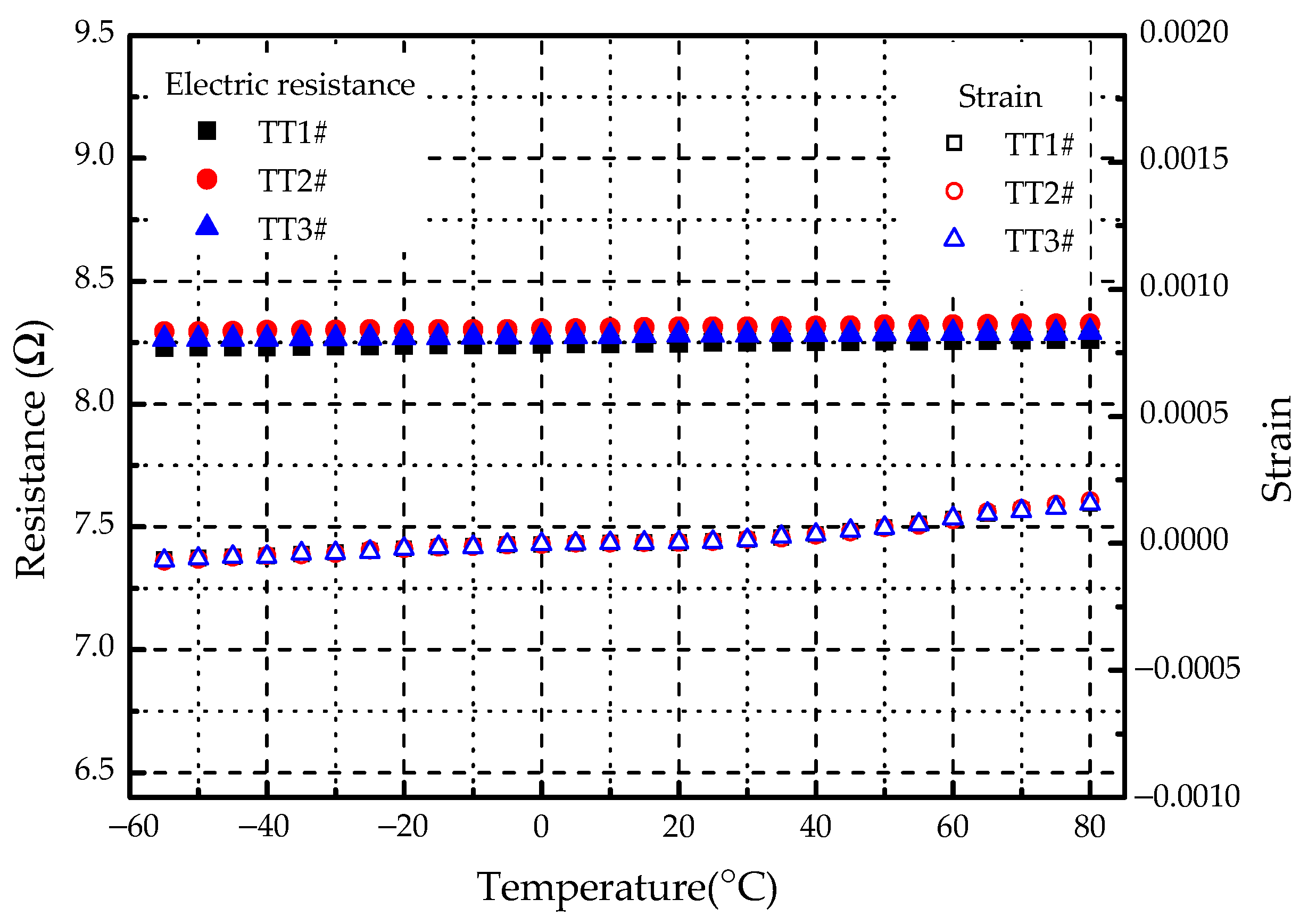

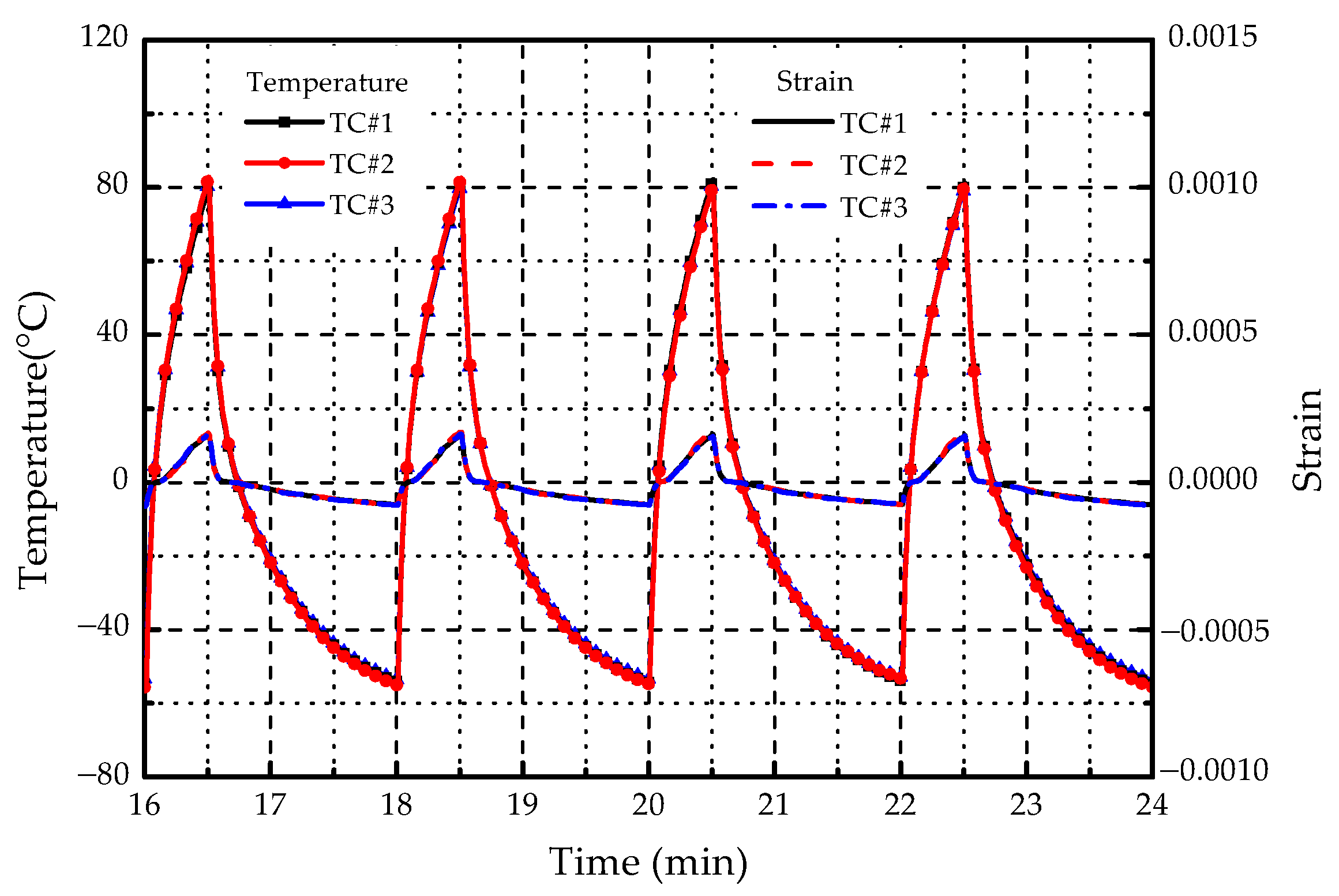
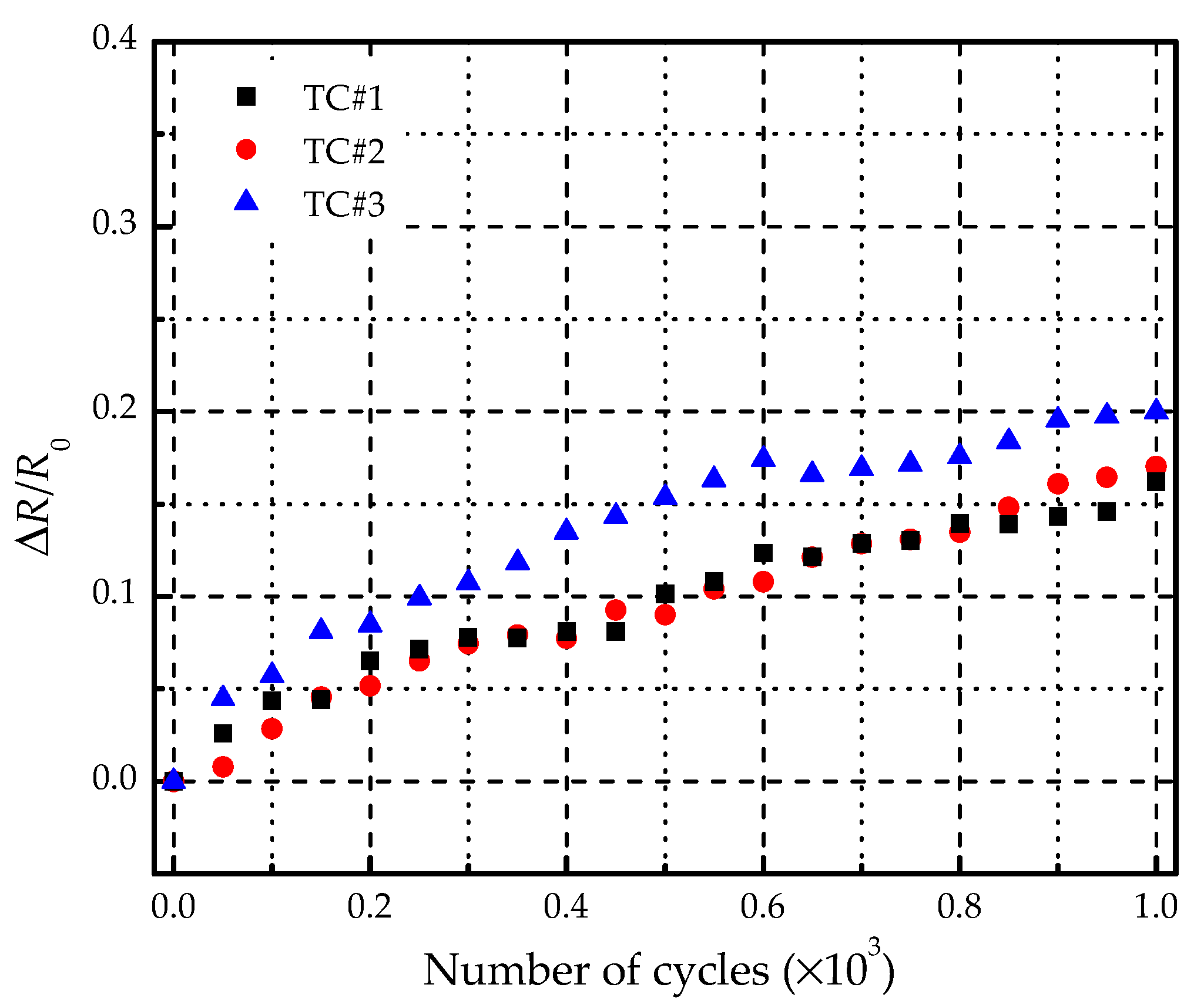
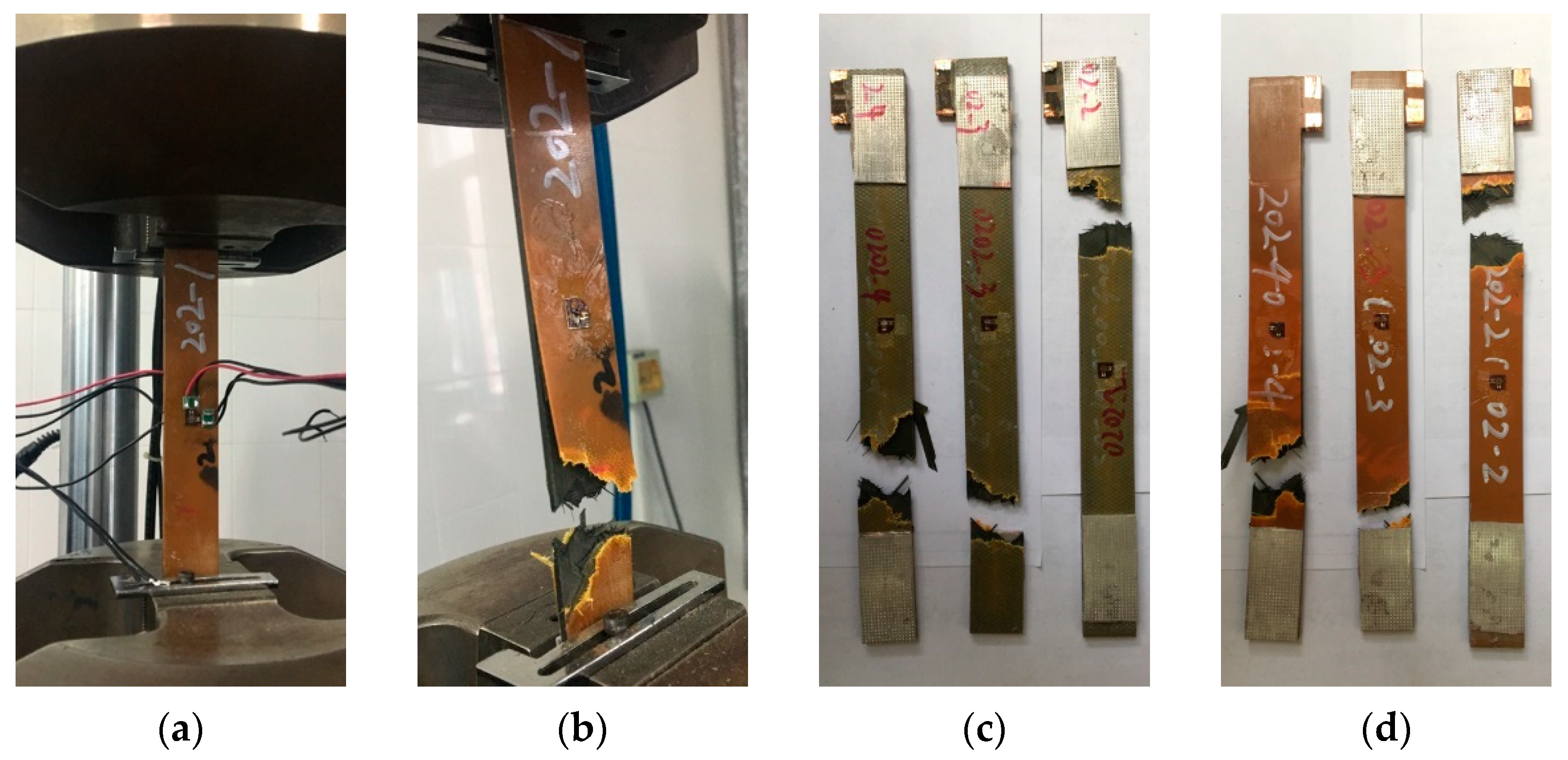

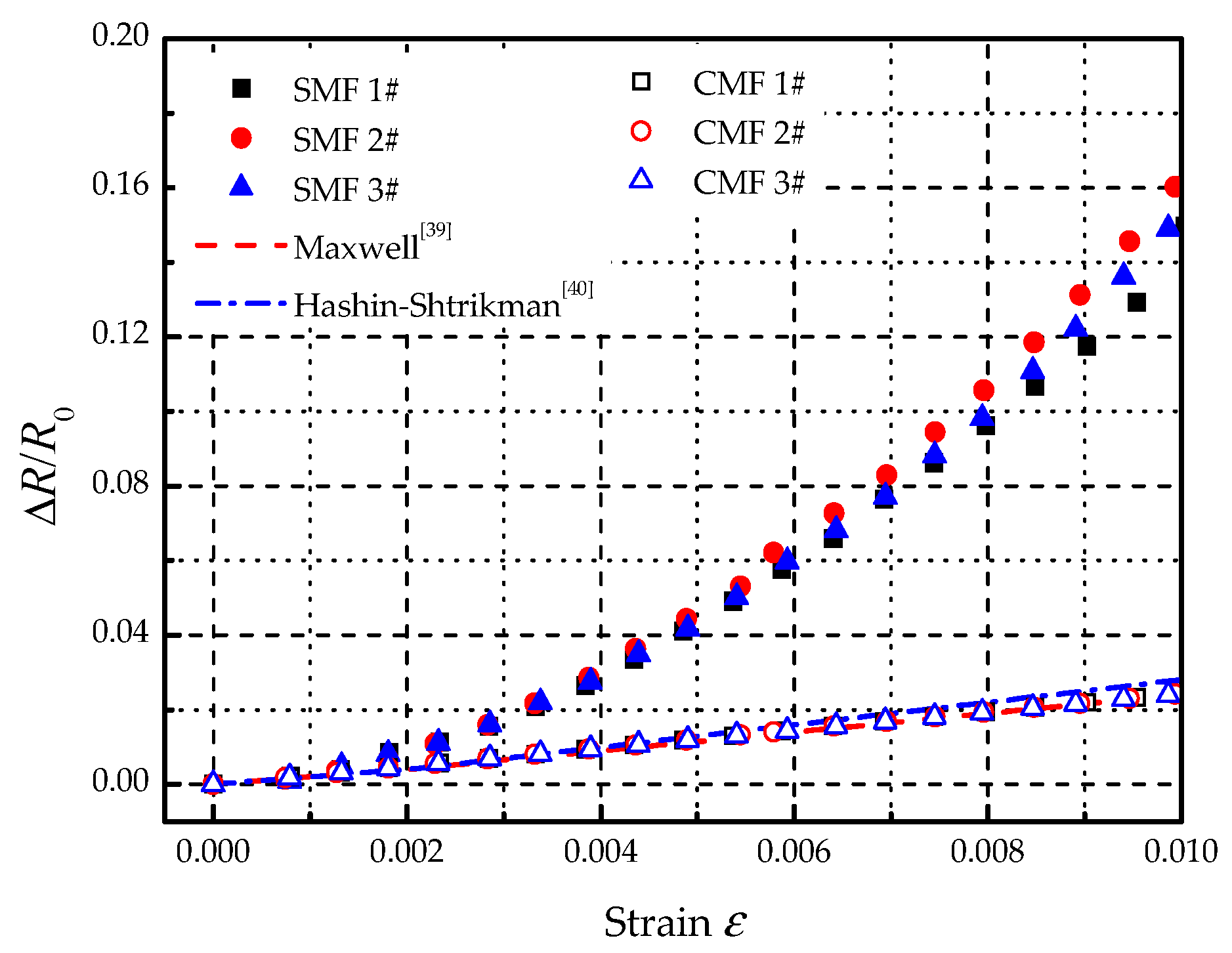

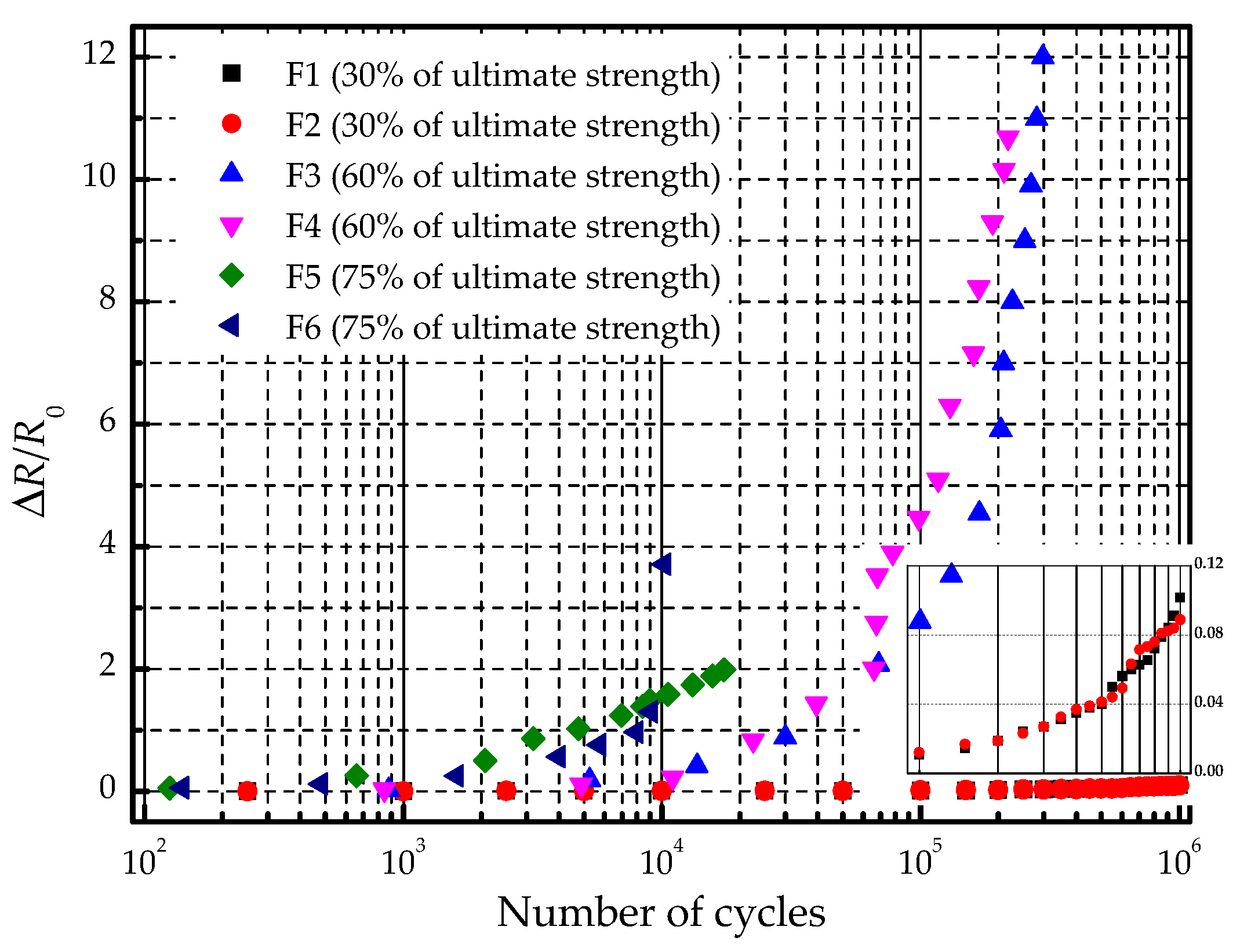
| Material | Thickness, mm | Designation | |
|---|---|---|---|
| Copper screen | 0.3 | CMS-AD-107-II-2-B-022 | |
| Glass fiber layers | a | 0.2 | CMS-CP-313-I-4-120 |
| b | 0.2 | ||
| c | 0.4 | ||
| SMF | 0.1 | Cu-Mn alloy | |
| Carbon fiber layers | 2.34 | CMS-CP-306-35-1-130 | |
| Specimens | Stress, MPa | Frequency, Hz | Target Cycles | Remark |
|---|---|---|---|---|
| F1 | 111 | 5 | 1,000,000 | 30% of compressive ultimate strength |
| F2 | ||||
| F3 | 222 | 5 | 1,000,000 | 60% of compressive ultimate strength |
| F4 | ||||
| F5 | 277.5 | 5 | 1,000,000 | 75% of compressive ultimate strength |
| F6 |
| Specimens | Initial Resistance, Ω | Final Resistance, Ω | Structural Fatigue Life (Cycles) | Functional Fatigue Life (Cycles) |
|---|---|---|---|---|
| F1 | 13.09 | 14.42 | 1,000,000 | 1,000,000 |
| F2 | 12.39 | 13.49 | 1,000,000 | 1,000,000 |
| F3 | 11.78 | ∞ | 422,591 | 296,698 |
| F4 | 11.65 | ∞ | 461,653 | 217,502 |
| F5 | 10.06 | ∞ | 17,370 | 17,370 |
| F6 | 12.75 | ∞ | 10,686 | 10,686 |
Publisher’s Note: MDPI stays neutral with regard to jurisdictional claims in published maps and institutional affiliations. |
© 2021 by the authors. Licensee MDPI, Basel, Switzerland. This article is an open access article distributed under the terms and conditions of the Creative Commons Attribution (CC BY) license (http://creativecommons.org/licenses/by/4.0/).
Share and Cite
Li, R.; Xu, W.; Zhang, D. Impacts of Thermal and Mechanical Cycles on Electro-Thermal Anti-Icing System of CFRP Laminates Embedding Sprayable Metal Film. Materials 2021, 14, 1589. https://doi.org/10.3390/ma14071589
Li R, Xu W, Zhang D. Impacts of Thermal and Mechanical Cycles on Electro-Thermal Anti-Icing System of CFRP Laminates Embedding Sprayable Metal Film. Materials. 2021; 14(7):1589. https://doi.org/10.3390/ma14071589
Chicago/Turabian StyleLi, Rongjia, Wang Xu, and Dalin Zhang. 2021. "Impacts of Thermal and Mechanical Cycles on Electro-Thermal Anti-Icing System of CFRP Laminates Embedding Sprayable Metal Film" Materials 14, no. 7: 1589. https://doi.org/10.3390/ma14071589






